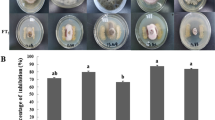Abstract
Plant diseases seriously affect the agricultural economy and eco-environment. Recently, the agricultural application of endophytes has received considerable attention due to its environmentally friendly characteristics. In this study, endophytes of Tinospora capillipes Gagnep. were isolated, and antagonistic endophytes were screened to explore their biological characteristics and promoting effects, which can lay the foundation for exploring green biocontrol strains. Based on the identification results, two endophytes with antagonistic effect of plant pathogens were identified as Epicoccum nigrum and Arthrinium phaeospermum respectively. Both strains possessed various extracellular enzyme activities, phosphorus hydrolysis and low Indole-3-acetic acid (IAA) production capacity. A. phaeospermum showed potassium-solubilizing ability while E. nigrum lacked this ability. Both spore suspension and fermentation supernatant of E. nigrum could promote soybean seeds rooting at low concentration. The spore suspension of A. phaeospermum had obvious promoting effect on seeds rooting at high concentration while its fermentation supernatant did not. The main composition of volatile components of A. phaeospermum was phenylethyl alcohol (2-PE). The co-culture of A. phaeospermum with plants could promote the growth of maize seedlings’ taproots, indicating that A. phaeospermum was able to be exploited as sustainable and environment-friendly biocontrol strain in agriculture.








Similar content being viewed by others
References
Alvin A, Miller KI, Neilan BA (2014) Exploring the potential of endophytes from medicinal plants as sources of antimycobacterial compounds. Microbiol Res 169(7–8):483–495
Anthati M, Digeshwar R, Syed GD, Chikkarasanahalli SVB (2020) Plant Probiotic Bacterial Endophyte, Alcaligenes Faecalis, modulates Plant Growth and Forskolin Biosynthesis in Coleus Forskohlii. Probiotics and Antimicrobial Proteins 12(2):481–493
Bernardi C, Rey MS, Junior AW, Pietrobom JH, Barros DR (2022) First Report of Epicoccum nigrum Causing Leaf Spot of Eugenia involucrata in Brazil. Plant Dis. 10.1094
Card SD, Bastías DA, Caradus JR (2021) Antagonism to Plant Pathogens by Epichloë Fungal Endophytes-A Review. Plants (Basel) 10(10):1997
Chang KL, Zhang L, Zhou HY, Zhang CX, Ye HX, Mei XG (2021) Application and Research Progress of Endophyte Resources of Medicinal plants in Agriculture. Shandong Agricultural Sciences 53:135–141 (in Chinese)
Chaudhary T, Yadav D, Chhabra D, Gera R, Shukla P (2021) Low-cost media engineering for phosphate and IAA production by Kosakonia pseudosacchari TCPS-4 using multi-objective genetic algorithm (MOGA) statistical tool. 3 Biotech 11(4):158
Chen XR, Wang ZY, He XP (2016) Advances in biosynthesis of 2-phenylethanol by yeasts. Chin J Biotechnol 32(9):1151–1163 (in Chinese)
Chi LP, Li XM, Li L, Li X, Wang BG (2020) Cytotoxic thiodiketopiperazine derivatives from the Deep Sea-Derived Fungus Epicoccum Nigrum SD-388. Mar Drugs 18(3):160
Del Carmen H, Rodríguez M, Evans HC, de Abreu LM, de Macedo DM, Ndacnou MK, Bekele KB, Barreto RW (2021) New species and records of Trichoderma isolated as mycoparasites and endophytes from cultivated and wild coffee in Africa. Sci Rep 11(1):5671
Del Frari G, Cabral A, Nascimento T, Boavida Ferreira R, Oliveira H (2019) Epicoccum layuense a potential biological control agent of esca-associated fungi in grapevine. PLoS One Mar 26(3):e0213273
Erika S, Eliana N, Alessio A, Antonio M, Carlo S, Roberto L, Luigi DB (2015) Arthrinium Phaeospermum isolated from Tuber Borchii Ascomata: the First evidence for a “Mycorrhization helper Fungus”? Mycological progress 14(8).
Feng SX, Ma XJ, Yan ZG, Hang X (2011) Effect of Harvest and Processing on Quality of Tinospora capillipes. Hubei Agricultural Sciences 50:3597–3599 (in Chinese)
Guo DJ, Singh RK, Singh P, Li DP, Sharma A, Xing YX, Song XP, Yang LT, Li YR (2020) Complete genome sequence of Enterobacter roggenkampii ED5, a Nitrogen fixing Plant Growth promoting endophytic bacterium with Biocontrol and stress Tolerance Properties, isolated from sugarcane Root. Front Microbiol 11:580081
Harwoko H, Lee J, Hartmann R et al (2020) Azacoccones F-H, new flavipin-derived alkaloids from an endophytic fungus Epicoccum nigrum MK214079. Fitoterapia 146:104698
Hereme R, Morales-Navarro S, Ballesteros G et al (2020) Fungal endophytes exert positive Effects on Colobanthus quitensis under water stress but Neutral under a projected climate change scenario in Antarctica. Front Microbiol 11:264
Jan FG, Hamayun M, Hussain A et al (2019) A promising growth promoting Meyerozyma caribbica from Solanum xanthocarpum alleviated stress in maize plants. Biosci Rep 39(10):BSR20190290
Khan SA, Hamayun M, Kim HY, Yoon HJ, Seo JC, Choo YS, Lee IJ, Kim SD, Rhee IK, Kim JG (2009) A New strain of Arthrinium Phaeospermum isolated from Carex Kobomugi Ohwi is capable of Gibberellin Production. Biotechnol Lett 31(2):283–287
Kim B, Cho BR, Hahn JS (2014) Metabolic Engineering of Saccharomyces Cerevisiae for the production of 2-Phenylethanol Via Ehrlich Pathway. Biotechnol Bioeng 111(1):115–124
Kim SY, Song MK, Jeon JH, Ahn JH (2018) Current status of Microbial Phenylethanoid Biosynthesis. J Microbiol Biotechnol 28(8):1225–1232
Kong WL, Li PS, Wu XQ, Wu TY, Sun XR (2020) Forest Tree Associated Bacterial Diffusible and Volatile Organic Compounds against various phytopathogenic Fungi. Microorganisms 8(4):590
Lebrazi S, Fadil M, Chraibi M, Fikri-Benbrahim K (2020) Screening and optimization of Indole-3-Acetic acid production and phosphate solubilization by rhizobacterial strains isolated from Acacia Cyanophylla Root Nodules and their Effects on its plant growth. J genetic Eng Biotechnol 18(1):21
Lee AJ, Cadelis MM, Kim SH, Swift S, Copp BR, Villas-Boas SG (2020) Epipyrone A, a broad-spectrum antifungal compound produced by Epicoccum nigrum ICMP 19927. Molecules 25(24):5997
Lei F, Liu X, Huang H, Fu S, Zou K, Zhang S, Zhou L, Zeng J, Liu H, Jiang L, Miao B, Liang Y (2021) The Macleaya cordata Symbiont: revealing the Effects of Plant Niches and Alkaloids on the Bacterial Community. Front Microbiol 12:681210
Léia CLF, Fernanda LDSS, Welington LA (2017) Epicoccum Nigrum P16, a sugarcane endophyte, produces Antifungal Compounds and induces Root Growth. Public Libr Sci one 7(6):e36826
Li MW, Lang XY, Marcos M, Sawyer DK, Sun XY, Nancy DS, Ian W (2021) CRISPR-mediated Multigene Integration Enables Shikimate Pathway Refactoring for Enhanced 2-Phenylethanol Biosynthesis in Kluyveromyces Marxianus. Biotechnology for biofuels 14(1):3
Li S, Tang Y, Fang X, Qiao T, Han S, Zhu T (2020) Whole-genome sequence of Arthrinium phaeospermum, a globally distributed pathogenic fungus. Genomics 112(1):919–929
Li YS, Li WZ, Wei P, Qiu SQ (2016) Determination of Columbin in Radix Tinosporae from different Origins. J Pharm Res 35:328–330 (in Chinese)
Liu YK, Zhou W, Chen ZL (2018) Determination of active components in Tinospora capilliPes Gagnep. by nonaqueous capillary electrophoresis and mass spectrometry.(eds.) Proceedings of 2018 China Mass Spectrometry Conference (pp.232). (in Chinese)
Mahadevakumar S, Jayaramaiah KM, Janardhana GR (2014) First Report of Leaf Spot Disease caused by Epicoccum nigrum on Lablab purpureus in India. Plant Dis 98(2):284
Melgarejo P, Carrillo R, Sagasta EM (1987) Potential for Biological Control of Monilinia Laxa in Peach Twigs. Crop Prot 5(6):422–426
Mina S, Ahmad M, Naser S (2018) Elicitors Derived from Hazel (Corylus Avellana L.) cell suspension culture enhance growth and Paclitaxel Production of Epicoccum Nigrum. Sci Rep 8(1):12053
Monggoot S, Popluechai S, Gentekaki E, Pripdeevech P (2017) Fungal endophytes: an alternative source for production of Volatile Compounds from Agarwood Oil of Aquilaria Subintegra. Microb Ecol 74(1):54–61
Ogórek R, Przywara K, Piecuch A, Cal M, Lejman A, Matkowski K (2020) Plant-fungal interactions: a case study of picoccoum nigrum Link. Plants (Basel) 9(12):1691
Pedraza-Zapata DC, Sánchez-Garibello AM, Quevedo-Hidalgo B, Moreno-Sarmiento N, Gutiérrez-Rojas I (2017) Promising Cellulolytic Fungi isolates for Rice Straw Degradation. J Microbiol 55:711–719
Petrini O (1991) Fungal endophytes of tree leaves. Springer, New York
Philip NV, Koteshwara A, Kiran GA, Raja S, Subrahmanyam VM, Chandrashekar HR (2020) Statistical optimization for coproduction of Chitinase and Beta 1, 4-Endoglucanase by Chitinolytic Paenibacillus Elgii PB1 having antifungal activity. Appl Biochem Biotechnol 191(1):135–150
Senanayake IC, Bhat JD, Cheewangkoon R, Xie N (2020) Bambusicolous Arthrinium Species in Guangdong Province, China Front Microbiol, 14;11:602773
Shi QR, Tang CM, Zhou YC, Zhang WD (2006) Preliminary study on Resources and Ecology of Chinese Medicine Tinospora capillipes.Journal of Chinese Medicinal Materials108–109. (in Chinese)
Su C, Xia WY, Yao HY (2003) Determination methods of glucosamine and N-acetylglucosamine.Science and Technology of Food Industry74–75. (in Chinese)
Ueki A, Takehara T, Ishioka G, Kaku N, Ueki K (2019) Production of Beta-1,3-Glucanase and chitosanase from clostridial strains isolated from the Soil subjected to Biological Disinfestation. AMB Express 23(1):114
Vurukonda SSKP, Giovanardi D, Stefani E (2018) Plant growth promoting and Biocontrol Activity of Streptomyces spp. As Endophytes International journal of molecular sciences 19(4):952
Wang X, Zhou X, Cai Z, Guo L, Chen X, Chen X, Liu J, Feng M, Qiu Y, Zhang Y, Wang A (2020) A Biocontrol strain of Pseudomonas Aeruginosa CQ-40 promote growth and control Botrytis Cinerea in Tomato. Pathogens (Basel Switzerland) 10(1):22
Wu LQ, Gu HK, Wang Q, Shang HZ, Liu GJ, Bao F (2016) Antagonistic efficacy and growth-promoting effect of Bacillus methylotrophicus isolated from Dendrobium huoshanense. Biotechnol Bull 32:200–206 (in Chinese)
Xia GJ (2014) Screening of the Yeast Strain for Resistance and Higher Production of 2-Phenylethanol with UV Mutagenesis and gTME. Dissertation, Zhejiang university of technology.(in Chinese)
Yadav G, Meena M (2021) Bioprospecting of endophytes in medicinal plants of Thar Desert: an attractive resource for biopharmaceuticals.Biotechnology reports (Amsterdam, Netherlands)30, e00629
Yan L, Zhu J, Zhao X, Shi J, Jiang C, Shao D (2019) Beneficial Effects of Endophytic Fungi colonization on plants. Appl Microbiol Biotechnol 103(8):3327–3340
Yang YX, LIN BX, Wang HL, Chen TZ, Chen S, Xia YL, Hu P (2020) Analysis of correlation, regression and path between main agronomic characters and yield of Tinospora capillipes. Seed 39:106–108 (in Chinese)
Yang ZJ, Deng Y, Man Q, Yang XJ, Yang YZ (2018) Progress in search for endophytes associated with natural medicine. Chin J Clin Pharmacol 34(05):593–596 (in Chinese)
Yin Q, Jiang S, Li D et al (2021) First Report of Epicoccum nigrum Causing Brown Leaf Spot in Tea in Guizhou Province, China. Plant Dis 10.1094
Zahoor AW, Nasheeman A, Tabasum M, Syed R (2015) Plant-endophyte symbiosis, an ecological perspective. Appl Microbiol Biotechnol 99(7):2955–2965
Zhang HF, Li XH, He G, Chen Y (2020) Community structure of Culturable Endophytic Fungi isolated from Emmenopterys Henryi Oliv. And screening for functional activated strains. Ecol Sci 39:34–47 (in Chinese)
Zhu JN, Yu YJ, Dai MD, Zeng YL, Lu XJ, Wang L, Liu XH, Su ZZ, Lin FC (2022) A New Species in Pseudophialophora from Wild Rice and Beneficial potential. Front Microbiol 11:13:845104
Zouari I, Masmoudi F, Medhioub K, Tounsi S, Trigui M (2020) Biocontrol and Plant Growth-Promoting potentiality of Bacteria isolated from Compost Extract. Antonie Van Leeuwenhoek 113:2107–2122
Funding
This study was funded by the Zhejiang Provincial Natural Science of Foundation of China [Grant number LQ20B070005] and Zhejiang Provincial Fund for Outstanding Young Talents of Traditional Chinese Medicine [Grant number 2020ZQ013].
Author information
Authors and Affiliations
Contributions
All authors contributed to the study conception and design. The experiments were designed by Zhishan Ding, Xiaoqing Ye, and Qianxi Li. The experiments were performed by Qianxi Li, Siyu Wang, Senmiao Chen and Yini Shang. The data analysis was performed by Qianxi Li, Siyu Wang and Xiaoqing Ye. The technical support was provided by Fangmei Zhou and Jie Yu. The first draft of the manuscript was written by Qianxi Li and all authors commented on previous versions of the manuscript. All authors read and approved the final manuscript.
Corresponding author
Ethics declarations
Statements and declarations
The authors have no relevant financial or non-financial interests to disclose.
Additional information
Publisher’s Note
Springer Nature remains neutral with regard to jurisdictional claims in published maps and institutional affiliations.
Electronic supplementary material
Below is the link to the electronic supplementary material.
Rights and permissions
Springer Nature or its licensor (e.g. a society or other partner) holds exclusive rights to this article under a publishing agreement with the author(s) or other rightsholder(s); author self-archiving of the accepted manuscript version of this article is solely governed by the terms of such publishing agreement and applicable law.
About this article
Cite this article
Li, Q., Wang, S., Chen, S. et al. Identification of volatile components and growth promoting effects of endophytes of Tinospora capillipes Gagnep.. J Plant Pathol 105, 57–68 (2023). https://doi.org/10.1007/s42161-022-01282-0
Received:
Accepted:
Published:
Issue Date:
DOI: https://doi.org/10.1007/s42161-022-01282-0




